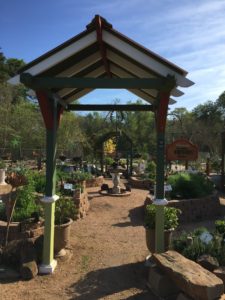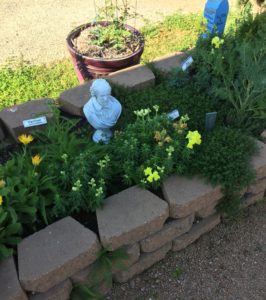By Pat Sheridan, Master Gardener

Entry to Herb Area in MCMGA Demonstration Gardens
A garden organized around a unifying theme is a theme garden. Ideas for theme gardens are limitless. There are Japanese gardens, butterfly gardens, rose gardens, and vegetable gardens, to name just a few. Here at the AgriLife Extension, we have several examples of theme gardens: the children’s discovery garden, the square foot garden, the fairy garden, and the culinary herb garden, and more.
Checkout the Shakespeare Garden…

Shakespeare Garden at MCMGA Demonstration Gardens
Within the Herb Area lies the Shakespeare Garden:
“I know a bank where the wild thyme blows…” A Midsummer Night’s Dream
“Rosemary, that’s for remembrance…” Ophelia
“What’s in a name? That which we call a rose…” Romeo and Juliet
Did you know that herbs and other plants were frequently mentioned in the plays and sonnets of William Shakespeare? It seems that he was very knowledgeable of the characteristics and uses of many plants. In his day (the 1600s), plants had symbolic significance. Every mention is thought to be important to the story. His writings speak about more than 30 different herbs and flowers and the settings were sometimes in gardens.
Our Shakespeare garden features bronze fennel, creeping thyme, chamomile, yarrow, rosemary, bay laurel, tansy, rue, the red rose, but plants may vary with the season and weather conditions. We even have a bust of old Will himself to watch over the plants in his garden.
Some well- known public gardens in America that contain areas dedicated to Shakespeare are located in Central Park in New York City, Golden Gate Park in San Francisco, and on the Folger Shakespeare Library grounds, Washington, D.C. Closer to home, Festival Hill and Mercer Botanical Gardens are worth a visit.